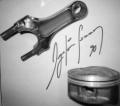Final Touch 01
by , 21-05-2014 at 12:52 PM (3957 Views)
Iíve already completed short distance multiple test driving sessions before
going out for the long run so doing another catch up updating the blog.......
After all these weeks, by now, the bottom section of the radiator should be dry.
However, after so many fire up, I noticed this at the right bottom section
near the lower coolant hose neck.
The area around this hose neck is the most common place for the radiator to
crack due to thermal shock as hot coolant enters from the bottom side on
our NSX and not from the upper side, like on most of other production cars.
The seepage is not from the neck and it looked more like from the
crimped section or since the area was covered in mud, it could be from the
bottom pin section and allowing the seepage to move upwards.
Originally, I recommended the owner to replace all coolant hoses and also
the radiator but these were removed from the service menu.
As mentioned many times, the radiator is a consumable parts and
all of them will fail sooner or later. Addition to the refurbishing of wheel,
I'm surprised that the radiator was not replaced regularly in UK.
Unfortunately, itís one of the most neglected services on any car
maintenance.
My background is motor racing so Iím against the common notion of
'donít fix it unless it's broken'.
Regardless of whether it is broken or not, we will replace any parts that
have reached their design spec, specified lifeing mileage/time or anything
suspicious.
Also, as I mentioned many times on this site, my service is not everyone's
cup of tea and what I want to do is not necessarily the same as the owners.
However, most of the time, postponing the service wonít save anything
in longer term and almost all the time, it will be the opposite and will
cost more for the owner later.
After looking at this, I felt I should have pushed the owner harder and
forced to replace the radiator and the cooling hoses this time....
It was not part of the service menu but while I had access to it, felt the
state of the centre floor coolant hoses as they are one of the most common
place to experience hose bursting with age and heat.
For now, they were fine.
I just hope the radiator wonít crack during the test driving session as
I need to cover many miles/sessions this time after the head gasket job
and the thermal shock won't help.

Couldnít put the camera at the ideal angle but the entire base section of
the oil pan drain bolt (sump bolt) looked to be deformed at slight angle.
It even looked as if it expanded/pushed outward.
Because of this, even with the new washer and at specified torque,
I couldnít stop the eng oil from seeping. Itís not enough to drip on the floor but
donít want to use extra torque so at some point in the future,
best to replace the oil pan.
There are lots of oil seepage from around the pan gasket as well so
makes sense to replace the pan itself when replacing the gasket.








 Email Blog Entry
Email Blog Entry

